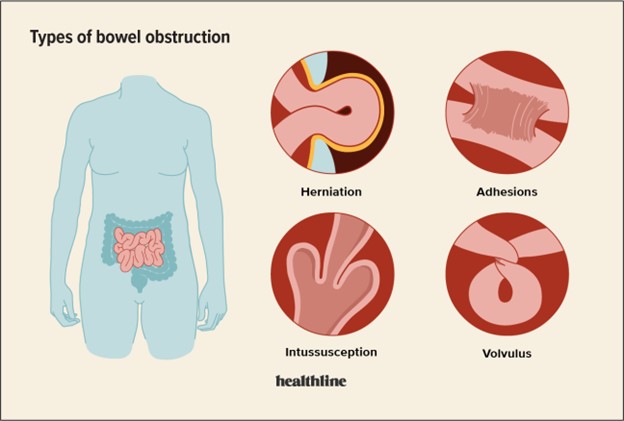A client has just had surgery to create an ileostomy. The nurse assesses the client in the immediate postoperative period for which most frequent complication of this type of surgery?
Intestinal obstruction
Folate deficiency
Malabsorption of fat
Fluid and electrolyte imbalance
The Correct Answer is D
Choice A Reason: This is incorrect because intestinal obstruction is not a common complication of ileostomy surgery. An ileostomy is a surgical opening in the abdomen that connects the end of the small intestine (ileum) to a pouch or bag outside the body. This allows stool to bypass the colon and rectum. Intestinal obstruction can occur if there is a blockage or narrowing in any part of the digestive tract, but it is more likely to affect the colon than the ileum.
Choice B Reason: This is incorrect because folate deficiency is not a common complication of ileostomy surgery. Folate is a vitamin that is essential for DNA synthesis and cell division. Folate is mainly absorbed in the jejunum, which is the middle part of the small intestine. An ileostomy does not affect the jejunum, so it does not interfere with folate absorption.
Choice C Reason: This is incorrect because malabsorption of fat is not a common complication of ileostomy surgery. Fat is digested and absorbed in both the small and large intestine. An ileostomy does not affect fat digestion, but it may reduce fat absorption by decreasing the transit time and surface area of the intestine. However, this is usually not significant enough to cause malabsorption symptoms.
Choice D Reason: This is correct because fluid and electrolyte imbalance is a common complication of ileostomy surgery. Fluid and electrolytes are mainly absorbed in the colon, which is bypassed by an ileostomy. This can result in increased fluid and electrolyte loss through stool, especially sodium and potassium. This can lead to dehydration, hypotension, weakness, cramps, or arrhythmias.

Nursing Test Bank
Naxlex Comprehensive Predictor Exams
Related Questions
Correct Answer is D
Explanation
Choice A Reason: Colorectal cancer is not likely to cause nausea with projectile vomiting or high-pitched sounds in the left upper quadrant. Colorectal cancer may cause symptoms such as rectal bleeding, change in bowel habits, abdominal pain, or weight loss.
Choice B Reason: Paralytic ileus is a condition where the bowel stops working and does not contract or move food along. Paralytic ileus may cause symptoms such as abdominal distension, absence of bowel sounds, constipation, or vomiting.
Choice C Reason: Large bowel obstruction is a blockage of the colon or rectum that prevents the passage of stool. Large bowel obstruction may cause symptoms such as abdominal distension, low-pitched sounds in the right lower quadrant, constipation, or ribbon-like stools.
Choice D Reason: Small bowel obstruction is a blockage of the small intestine that prevents the passage of food and fluids. Small bowel obstruction may cause symptoms such as nausea with projectile vomiting, high-pitched sounds in the left upper quadrant, abdominal cramps, or dehydration.

Correct Answer is C
Explanation
Choice A reason: This is incorrect because acute hemorrhagic stroke is not consistent with these observations. Acute hemorrhagic stroke is a sudden bleeding in the brain that can cause severe neurological deficits, such as paralysis, aphasia, or coma. It does not cause tremors, slowness, or mask-like facial expressions.
Choice B reason: This is incorrect because Alzheimer's disease is not consistent with these observations. Alzheimer's disease is a progressive degeneration of the brain that causes cognitive impairment, memory loss, and behavioral changes. It does not cause tremors, slowness, or mask-like facial expressions.
Choice C reason: This is the correct answer because Parkinson's disease is consistent with these observations. Parkinson's disease is a chronic disorder of the brain that affects movement and coordination. It causes tremors, slowness, rigidity, and postural instability, as well as mask-like facial expressions due to reduced facial muscle activity.
Choice D reason: This is incorrect because traumatic brain injury is not consistent with these observations. Traumatic brain injury is damage to the brain caused by external force, such as a blow, fall, or penetration. It can cause various neurological symptoms depending on the location and severity of the injury, but it does not typically cause tremors, slowness, or mask-like facial expressions.
Whether you are a student looking to ace your exams or a practicing nurse seeking to enhance your expertise , our nursing education contents will empower you with the confidence and competence to make a difference in the lives of patients and become a respected leader in the healthcare field.
Visit Naxlex, invest in your future and unlock endless possibilities with our unparalleled nursing education contents today
Report Wrong Answer on the Current Question
Do you disagree with the answer? If yes, what is your expected answer? Explain.
Kindly be descriptive with the issue you are facing.
